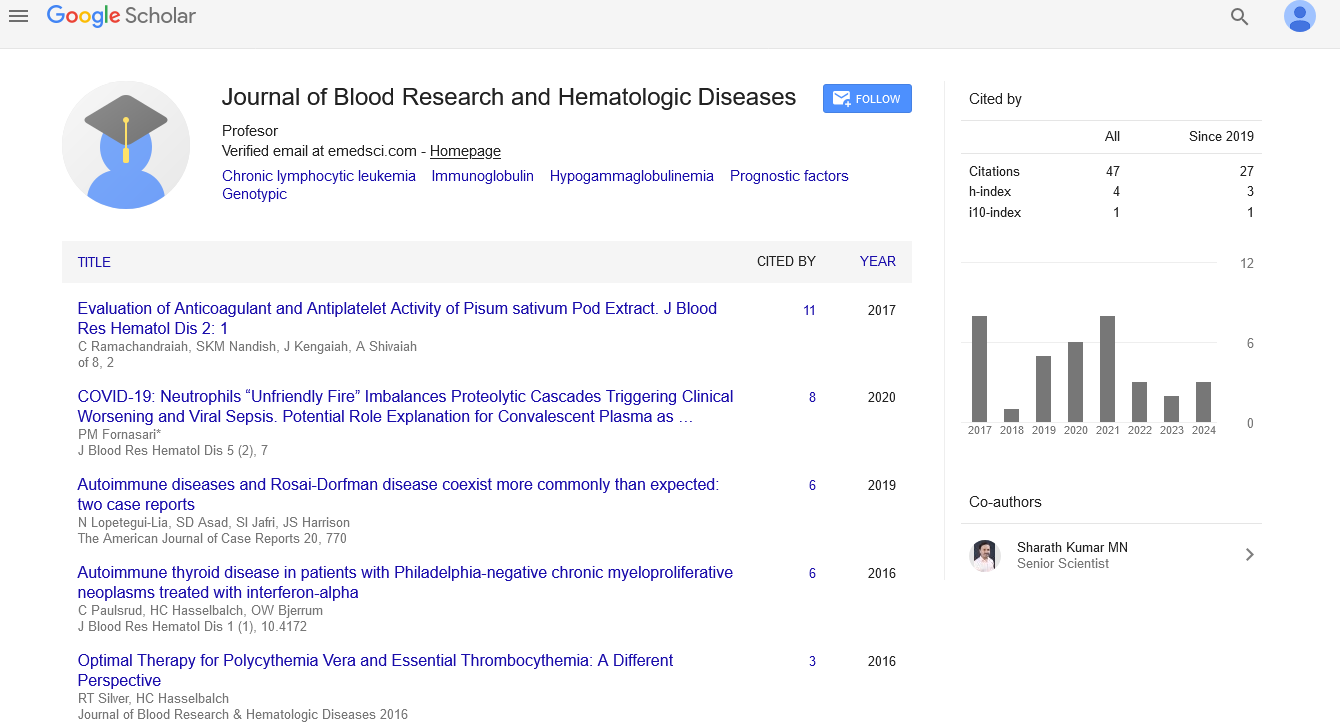Commentary, J Blood Res Hematol Dis Vol: 10 Issue: 1
Current Perspectives on Thrombosis: Diagnosis and Treatment Strategies
Chrggiano Noaitlen*
Department of Hematology, Erasmus University Medical Center, Rotterdam, The Netherlandsom
*Corresponding Author:Chrggiano Noaitlen
Department of Hematology, Erasmus University Medical Center, Rotterdam, The Netherlands
E-mail:chrggianonoa@gmail.com
Received date: 24 May, 2024, Manuscript No. JBRHD-24-137149;
Editor assigned date: 27 May, 2024, PreQC No. JBRHD-24-137149(PQ);
Reviewed date: 11 June, 2024, QC No. JBRHD-24-137149;
Revised date: 10 March, 2025, Manuscript No. JBRHD-24-137149(R);
Published date: 17 March, 2025, DOI: 10.4172/jbrhd.1000222
Citation: Noaitlen C (2025) Current Perspectives on Thrombosis: Diagnosis and Treatment Strategies. J Blood Res Hematol Dis 10:1.
Description
Thrombosis, the formation of blood clots within blood vessels, poses significant health risks ranging from heart attacks to strokes. Understanding the latest advancements in diagnosis and treatment strategies is crucial for effectively managing this condition and improving patient outcomes. This article explores the current perspectives on thrombosis, focusing on diagnostic techniques, treatment modalities, and emerging therapies.
Understanding thrombosis
Thrombosis occurs when blood clots form in arteries or veins, disrupting blood flow and potentially leading to serious complications. It can manifest as Deep Vein Thrombosis (DVT), where clots form in the deep veins of the legs, or as Pulmonary Embolism (PE), where clots travel to the lungs from elsewhere in the body. Thrombosis can also affect arteries, leading to conditions like myocardial infarction (heart attack) or ischemic stroke.
Diagnostic techniques
Accurate and timely diagnosis of thrombosis is essential for initiating appropriate treatment and preventing complications. Several diagnostic techniques are used depending on the suspected site of thrombosis:
D-Dimer test: This blood test measures the presence of D-dimer, a protein fragment produced when a blood clot breaks down. Elevated D-dimer levels may indicate the presence of an active clotting process, prompting further imaging tests.
Ultrasound imaging: Doppler ultrasound is commonly used to diagnose DVT by visualizing blood flow and detecting the presence of clots in the deep veins of the legs or arms.
CT Pulmonary Angiography (CTPA): CTPA is a specialized imaging technique used to diagnose PE by visualizing blood flow in the pulmonary arteries and identifying blockages caused by blood clots.
MRI and Magnetic Resonance Venography (MRV): These imaging modalities provide detailed images of blood vessels and are used when ultrasound or CT scans are inconclusive or when there is a need for more precise anatomical information.
Treatment strategies
The management of thrombosis aims to prevent clot extension, reduce the risk of embolization (clot detachment and migration), and minimize the risk of recurrence. Treatment strategies vary based on the type and severity of thrombosis:
Anticoagulant therapy: Anticoagulants, such as heparin and warfarin, are standard treatments for preventing the extension of existing clots and the formation of new ones. Direct Oral Anticoagulants (DOACs), such as rivaroxaban and apixaban, have gained popularity due to their efficacy, convenience (oral administration), and reduced need for frequent monitoring compared to traditional anticoagulants.
Thrombolytic therapy: Thrombolytic agents, such as alteplase (tissue plasminogen activator), are used in acute situations where rapid dissolution of a blood clot is necessary, such as in massive PE or ischemic stroke caused by arterial thrombosis. These medications work by breaking down the clot and restoring blood flow.
Inferior Vena Cava (IVC) filters: In cases where anticoagulation therapy is contraindicated or ineffective, IVC filters may be implanted to trap large emboli (clots) and prevent them from traveling to the lungs (PE) or other organs.
Compression stockings and mobilization: For patients with DVT, compression stockings and early mobilization are recommended to improve blood flow and reduce the risk of complications such as Post- Thrombotic Syndrome (PTS).
Emerging therapies and research
Research into new therapeutic approaches for thrombosis is ongoing, focusing on improving efficacy, safety, and patient outcomes:
Targeted therapies: Novel anticoagulants targeting specific components of the clotting cascade or using monoclonal antibodies to inhibit clot formation are being investigated.
Genetic testing: Genetic testing may help identify individuals at higher risk of thrombosis, enabling personalized treatment approaches.
Biomarkers: Biomarkers associated with thrombosis risk and response to treatment are being studied to refine diagnostic strategies and predict treatment outcomes.
Challenges and future directions
Despite advances in diagnosis and treatment, challenges such as bleeding complications with anticoagulant therapy, recurrent thrombosis, and the need for long-term management remain significant. Future research aims to address these challenges by developing safer and more effective therapies, enhancing predictive models for thrombosis risk, and improving patient adherence to treatment regimens.
Conclusion
In conclusion, current perspectives on thrombosis emphasize the importance of early diagnosis, individualized treatment strategies, and ongoing research into innovative therapies. By leveraging advancements in diagnostic techniques, such as biomarkers and imaging modalities, and tailoring treatment approaches based on patient-specific factors, healthcare providers can optimize outcomes and improve the quality of life for individuals affected by thrombotic disorders. Continued collaboration between researchers, clinicians, and patients is essential for advancing our understanding of thrombosis and translating scientific discoveries into clinical practice.
 Spanish
Spanish  Chinese
Chinese  Russian
Russian  German
German  French
French  Japanese
Japanese  Portuguese
Portuguese  Hindi
Hindi 